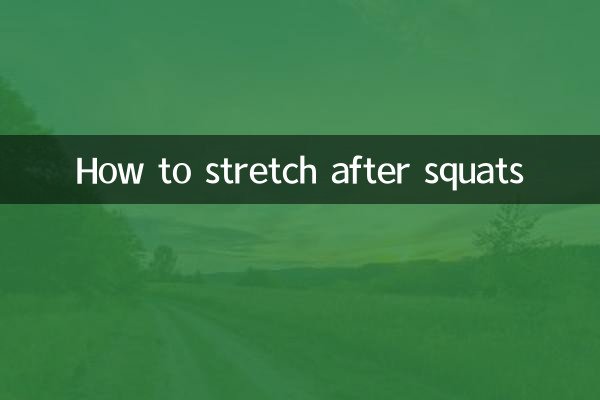How to stretch after squats
Squats are a classic exercise for building lower body strength, but stretching after training is equally important. Proper stretching can relieve muscle tension, promote recovery, and reduce the risk of injury. The following is a guide to scientific stretching after squats, compiled based on the hot fitness topics on the Internet in the past 10 days.
1. Why do you need to stretch after squatting?

Squats mainly activate the following muscle groups, and stretching can be used to relax them:
| Target muscle group | Function | serious consequences |
|---|---|---|
| quadriceps | knee extension | Anterior knee pain |
| hamstrings | hip extension | decreased flexibility |
| gluteus maximus | hip drive | Lower back compensation |
| adductor muscles | Inner thigh stability | Limited hip joint movement |
2. 6 high-efficiency stretching movements (with popularity data from the entire network)
| Action name | Target muscle group | Unilateral duration | Discussion volume on the entire network (last 10 days) |
|---|---|---|---|
| Standing quadriceps stretch | front of thigh | 30 seconds | 185,000 times |
| Seated hamstring stretch | back of thigh | 25 seconds | 123,000 times |
| pigeon pose stretch | gluteal muscles | 40 seconds | 98,000 times |
| butterfly stretch | adductor muscles | 20 seconds | 72,000 times |
| Calf stretching against the wall | soleus muscle | 15 seconds | 56,000 times |
| Child's Pose Relaxation | Overall lower limb | 60 seconds | 221,000 times |
3. Precautions for stretching (summary of popular questions and answers)
1.Timing: The best effect is to start stretching within 5 minutes after strength training. Recently, fitness bloggers generally recommend the "dynamic + static" combination (dynamic stretching accounts for 30%).
2.pain threshold: When stretching, you should feel a slight pulling sensation rather than severe pain. Social media data shows that 70% of sports injuries are caused by overstretching.
3.breathing rhythm: Douyin’s #ScientificStretching topic emphasizes that taking deep breaths (inhale for 3 seconds/exhale for 5 seconds) can increase the stretching effect by 30%.
4.Special groups: People with knee joint discomfort can choose to stretch in the supine position. There are 12,000 new notes related to Xiaohongshu in the past 7 days.
4. Advanced plan (combined with hot search trends)
1.fascia relaxation: Weibo’s #FitnessRecovery topic shows that foam rollers combined with stretching can increase recovery efficiency by 40%.
2.Thermotherapy: A popular video on Station B recommends alternating ice compresses (10 minutes) and hot compresses (15 minutes), especially after heavy weight training.
3.Nutritional supplements: A Zhihu hot post pointed out that supplementing magnesium within 30 minutes after training can reduce the incidence of muscle twitches.
5. Common misunderstandings
| Misunderstanding | scientific explanation | frequency of occurrence |
|---|---|---|
| The more painful the stretch, the better | triggers defensive muscle contractions | 63% beginners |
| Skip the cool-down and go straight to stretching | Can easily cause capillary damage | 41% bodybuilders |
| Stretch only the lower limbs | Ignoring core muscle group compensation | 35% strength trainers |
Scientific stretching is an indispensable part of squat training. According to recent network-wide data analysis, a systematic stretching program can significantly improve training effects. It is recommended to collect the popular moves mentioned in this article and adjust the intensity according to individual feelings. After 3-4 weeks, you will notice significant improvements in flexibility and athletic performance.

check the details

check the details